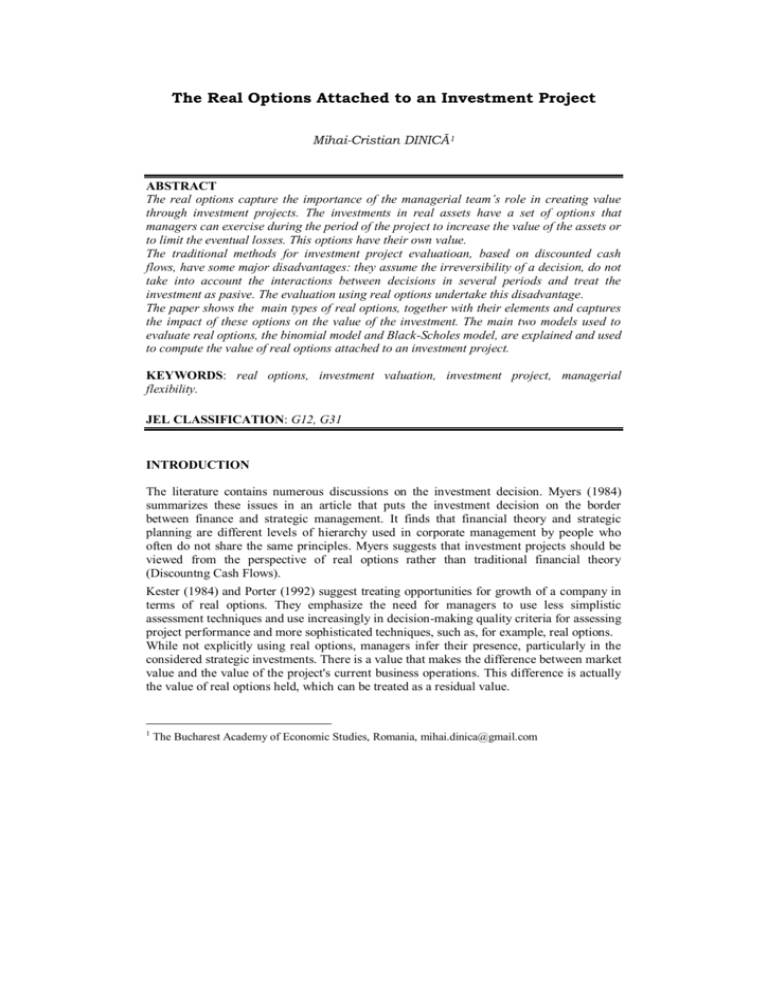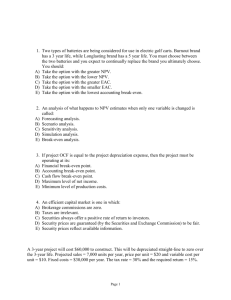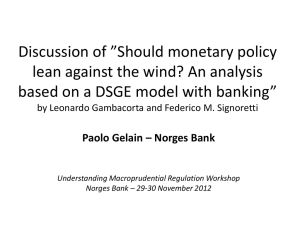The Real Options Attached to an Investment Project
advertisement

The Real Options Attached to an Investment Project Mihai-Cristian DINICĂ1 ABSTRACT The real options capture the importance of the managerial team’s role in creating value through investment projects. The investments in real assets have a set of options that managers can exercise during the period of the project to increase the value of the assets or to limit the eventual losses. This options have their own value. The traditional methods for investment project evaluatioan, based on discounted cash flows, have some major disadvantages: they assume the irreversibility of a decision, do not take into account the interactions between decisions in several periods and treat the investment as pasive. The evaluation using real options undertake this disadvantage. The paper shows the main types of real options, together with their elements and captures the impact of these options on the value of the investment. The main two models used to evaluate real options, the binomial model and Black-Scholes model, are explained and used to compute the value of real options attached to an investment project. KEYWORDS: real options, investment valuation, investment project, managerial flexibility. JEL CLASSIFICATION: G12, G31 INTRODUCTION The literature contains numerous discussions on the investment decision. Myers (1984) summarizes these issues in an article that puts the investment decision on the border between finance and strategic management. It finds that financial theory and strategic planning are different levels of hierarchy used in corporate management by people who often do not share the same principles. Myers suggests that investment projects should be viewed from the perspective of real options rather than traditional financial theory (Discountng Cash Flows). Kester (1984) and Porter (1992) suggest treating opportunities for growth of a company in terms of real options. They emphasize the need for managers to use less simplistic assessment techniques and use increasingly in decision-making quality criteria for assessing project performance and more sophisticated techniques, such as, for example, real options. While not explicitly using real options, managers infer their presence, particularly in the considered strategic investments. There is a value that makes the difference between market value and the value of the project's current business operations. This difference is actually the value of real options held, which can be treated as a residual value. 1 The Bucharest Academy of Economic Studies, Romania, mihai.dinica@gmail.com Mihai-Cristian DINICĂ To correctly take a decision regarding an investment project, Trigeorgis (1996) draws attention to the value of its two components, namely: Standard value, determined by traditional methods based on discounting cashflows, which doesn’t take into account adaptability and strategic value aspects The additional value (option premium), due to operational and strategic options held by active management, as well as the effects of competition, synergy and interdependence between the projects. Expanded (strategic) NPV = standard NPV (static, passive or direct) + + option premium Flexibility is a set of options associated with an investment project. Both decision trees, as well as real options capture managerial flexibility. Vintila (2007) shows that for projects with positive and high NPV is likely that flexibility doesn’t matter (it increases the value of the project, but the decision to adopt is maintained). For projects with negative NPV and higher value (in module) is likely that additional flexibility does not cover loss predicted, so the initial decision to reject the project is maintained. Flexibility and it’s accurate assessment are very helpful in adopting decision in either case that NPV is positive or negative,but with a low value. But we should not exaggerate and see the real options everywhere, even where they do not exist. It is recommended to limit the number of options used, so that the company can focus on core activity and to avoid wasting time and resources. The value of options has to do more with the management type practiced in the company and organizational culture than with the evaluation methodology used. It is not enough for a company to identify options and to properly evaluate them. To get value, these options must be exercised wisely and in a organizational structure ready to make decisions in line with thinking in terms of real options. Real options can also add value in case of mergers and aquisitions. Unlike financial options, real options have as underlying a real asset, whose value is given by the financial flows generated during the life of the project plus the value of other real options associated with holding the asset. Although the principle of real options has been used since ancient times, the notion was "invented" and the rigor of the evaluation was possible just in the twentieth century, from the '70s. In Aristotle's writings is a note on the use of real options. It seems that the sophist philosopher Thales predicted six months earlier a very rich harvest olives. For a small amount of money he bought from the owners of olive presses the right to rent them with six months before, for a predetermined amount. When the time to harvest olives arived, his predictions have come true, so the demand for processing capacity has grown tremendously, resulting in a corresponding increase of the rent for their use. Without knowledge of the concept as such, Thales used in this situation a real CALL option, which he exercised at maturity (6 months), earning the difference between the rent charged and the rent paid to the owners of presses under the initial agreement. He proved so that sophism was not only an honorable profession, but also a profitable business. 512 Economia. Seria Management Volume 14, Issue 2, 2011 1. CHARACTERISTICS OF REAL OPTIONS The specific characteristics of real options, which sepparate them from the financial ones, are outlined by Trigeorgis (1996) as follows: real options are not owned by only one investor. The possibility to invest in one area or industry can be valued by many competitors in the market. In an attempt to eliminate competition and to ensure the exclusivity of a project, a company must identify the competitive advantages it has over competitors and to build entry barriers, etc. real options are not negotiable. Their owner has only two alternatives: either to exercise the option (doing the project investment) or give up its exercise (no investment decision is taken), without existance of an organized market for selling these rights through negotiation to other people. real options give the investor who made the decision a right of preemptive investment. These investment options may not be sold and belong at the start to all firms involved in an industry. The company that decides starting investment project before its competitors (for example, expands production capacity to benefit from rising demand in the market) benefit of preemption, while in other conditions (no competition) would probably have preferred to defer a decision and wait accumulation of new information real options are mostly composed. Investment projects are often interdependent (projects with several stages of development, projects that can not be achieved without another previous project). Therefore real options are often more complex than financial ones, because their exercise may depend on the exercise of other options. Factors of influence in determining the theoretical value of an option were identified and included in the formula by Black and Scholes (1973). Expanding the use of theoretical models for determining the value of a financial option to real options is possible thanks to the analogy that can be achieved between financial and real options, at the level of the factors that influence their value. Thus, these influence factors are: the underlying asset price, exercise price, time to maturity, risk-free rate, volatility of the underlying asset. 2. MODELS FOR ASSESSING REAL OPTIONS The evaluation of options is based on the idea of building an arbitrage portfolio of financial assets subject to the same risks, that generates the same cash flows and the same value of the portfolio’s return. To determine the theoretical value of an European CALL option (C), the portfolio consists of buying a number N of undelying (also called the hedge ratio) at a rate S, while borrowing the amount B, which receives a risk-free interest rate. The European PUT option can be evaluated similarly, equivalent portfolio consisting of selling N shares at a rate S, while granting the loan amount B, at the risk-free rate of return r. Binomial model, as shown in Cox et al. (1979), is a discrete time model of evaluation which is based on perfect market assumption, where the market value of the call option (C) and the underlying (S) follows a binomial process. At the end of the period, the price of the underlying can increase or decrease on specific probabilities, with different values. Black-Scholes model is a continuous time model for evaluation of options, which is based on a number of specific assumptions: the model evaluates European style options; 513 Mihai-Cristian DINICĂ the underlying asset price follows a log normal distribution and its variation is a stochastic process, continuous, Wiener type. Black & Scholes (1973) formula sets the value of CALL option in continuous time: (1) Where (2) (3) Where: τ - Time to maturity N (d) represents the cumulative probability of normal distribution The Black Scholes formula to evaluate a European PUT options is: (4) 3. TYPES OF REAL OPTIONS Vintila (2007) shows that increasing the value of a project can be achieved by using a diversity of real options: timing options - the possibility of delaying the investment decision allows the accumulation of new information that clarify some uncertain variables of the project and thus create additional value; staging options - a variant of the timing options, the project is phased into several stages (initial is invested a smaller amount and after that the project will generate new information about its profitability), but unlike the previous category, the investment must be made (at least partially) in order to show the effect of learning on cost and profitability of the project; exit options - is a valuable option because it is the only way to avoid negative financial cash flows, by turning them into cash flows of zero; in addition, it is obtained a liquidation amount of the investment; operating options - allow investors to organize their operations to benefit from changes that would occur in business conditions; flexibility options - consist of the construction or purchase of assets that may have different uses, depending on the economic situation; growth options - are associated with those projects that, although have negative NPV (for example, investment in research), allow further projects with positive and large enough NPV to cover the loss generated by the original, indispensable, project. The most important types of real options are: option to delay (timing option), exit option and the expansion option. 514 Economia. Seria Management Volume 14, Issue 2, 2011 3.1. Option to Delay Correct assessment of options to delay a project is important not only for initial investments that have negative NPV. Even projects which are profitable from the outset (positive NPV) can gain additional value by extending the period of project implementation with a view to resolving uncertainty. Evaluation of an option to delay the project involves identifying the characteristic elements that are found in the evaluation model, as Damodaran (2002) shows: underlying asset - is the project to be realized, and its value is the discounted value of projected cash flows; exercise price - is the cost of the project, is working on the assumption that it is constant in real terms, being affected only by inflation, without being subject to uncertainty (evolution is deterministic and not stochastic); the period until maturity - is determined according to the time the investor benefits from the project exclusivity or at least has an important competitive advantage that allows postponement of the project without risking its execution by a competitor; risk-free interest rate - is determined in close connection with option maturity and represents the expected rate of return for a risk-free asset, having the same maturity; volatility of the underlying asset - is due to errors associated with estimating cash flows and underlying asset value and can be set using one of the following methods: o it is used the observed volatility of the cash flows for similar projects in the past; o if data are available, it is determinet the volatility of financial flows for projects in the same industry; o the volatility of cash-flows obtained through Monte Carlo simulation dividend rate - the loss of financial flows for each year of deferment of the project. After identifying the six elements it is used one of the presented models to determine the theoretical value of the option to delay the project. Black-Scholes model is preferred by users because the option value is determined simply by replacing in the formula the elements that characterize the project (the difficult stage is to identify and estimate these elements). Binomial model require more laborious calculations because the option value should be determined for each node of the binomial tree (the calculations are complicated with the growing period until maturity of the option). In addition, the binomial model allows considering a finite number of values for the underlying asset, being a discrete time model. At the limit, it leads to the Black-Scholes model, continuous time model, which considers that the term to maturity is divided into an infinite number of periods. Therefore, the call option value determined by the BlackScholes model is always smaller but close to the value determined using the binomial model (using Black-Scholes we don’t risk an overvaluation). 3.2. Exit option Exit option is associated with a PUT option. The value of the underlying asset is represented by the current value of all financial flows expected to be received by the project, and the volatility is estimated by the same categories of methods. The options’ 515 Mihai-Cristian DINICĂ duration is the period of time when the decision to drop out can be taken and may coincide with life expectancy for the project. Exercise price is the liquidation value obtained from exiting the investment, estimated at baseline. The evaluation model is applied to the situation that this value remains unchanged over time (real assets don’t lose their value). In reality, the investment is eroded over time (both physically and morally) and the loss of value may be surprised by the dividend rate. Real value at the time of exiting may be inferior to that estimated for various other reasons: there was no demand for such technology, there is no organized market to meet the demand and supply, a loss which can not be quantified and taken into account in the assessment model. So far I have implicitly assumed that the liquidation value is positive. There are situations where from abandonment of the investment doesn’t result anything and costs appear (different charges, etc..). In this case, the project will be abandoned only if the losses generated by continuing the operations are larger than the costs of liquidation proceedings. Exit option value increases when the investor started building a flexible operational structure, allowing greater ease adoption of the liquidation decision (for example, engage fixed-term labor, equipment is rented or leased, use a more expensive technology, but flexible). 3.3. Expansion option Evaluation of this option is done at the time of first investment, assuming that the investor can take advantage of the opportunity to expand only if he invested in the original project and the timeframe in which he can exercise the option to extend is known from the beginning. The items to be introduced in the evaluation model are similar to the ones of the option to delay. Characteristic expansion option is that it depends on two projects (and not one), so entries must be defined accordingly: underlying asset - is the expansion project and its value is the present value of cash flows that could be achieved if the investment had been made to extend today; exercise price - is the cost of the project for expansion, if it was done at baseline; the period until maturity - as opposed to the deferral option, where external factors dictated the duration, in this case the life of the option depends on the internal constraints set by the investor; risk-free interest rate - the rate of return that is expected for a asset without risk, having the same maturity as that established by the investor for expansion option; volatility of the underlying asset - the estimation of volatility is done by the same means like for the other options presented; dividend rate - the loss of cash flows until the decision, if expansion is not accomplished as soon as it becomes possible (which is also a delay cost). In evaluating expansion options appear some specific disadvantages. First, the value of the underlying assets and the exercise price are set from the begining, even if they are related to an expansion project that will be done over one, two or more years. Secondly, the length 516 Economia. Seria Management Volume 14, Issue 2, 2011 option is difficult to estimate, as determined subjectively by the investor. Unlike the delay option, where maturity is related to the existence of patents, licenses or at least holding important competitive advantages, in the case of expansion option there are no such clues. 4. REAL OPTIONS EVALUATION Assuming that an investment project with an initial cost of 1200 generates in 5 years discounted free cash-flows of 200, 300, 400, 500 and, respectively, 400, I computed the values of the real options attached to it. I assumed also that the risk-free rate is 7% and the volatility is 15%. For the option to delay I considered a period of 2 years for the project to be delayed and a dividend rate of 5%. For the exit option I considered a price of selling the investment of 60% from the initial value and a period when the investment can be abandoned of 5 years. For the expansion option, a period of 2 years in wich the option can be exercised was assumed. For an aditional investment of 200, there can be generate cashflows of 300. In the below table are synthetized the elements of the main real options and the values of this options are ilustrated. As it can be seen, for this virtual example, the option to delay has a very high value, close to the net present value. The posibility to wait until the uncertainty dissapears is very valuable. The exit and expansion option have a high value as well, aproximatively 10% of NPV. The results show that real options add value to the investment project. Table 1. Real options values Option elements Option to Delay Exit Option Expansion option Undelying asset value 1800 1800 300 Exercise price 1200 720 200 Period until maturity (y) 2 5 2 Risk-free rate 7% 7% 7% Volatility 15% 15% 15% Dividend rate 5% 556,50 20% 63,68 0% 72,74 Option Value Source: own calculations CONCLUSIONS Real options capture the role of the management team in creating value through investment projects. Depending on the flexibility they require, the investments in real assets have a set of options that managers can exercise during the period of the project to increase the value of the assets or to limit the eventual losses. These options have their own value and can be assessed using mathematical models such as binomial or Black-Scholes model. The traditional methods for investment project evaluation, based on discounted cash flows, have some major disadvantages: they assume the irreversibility of a decision, do not take into account the interactions between decisions in several periods and treat the investment as pasive. The evaluation using real options undertake this disadvantage. 517 Mihai-Cristian DINICĂ In this work I did a brief review of the literature in the field, presented the features of real options, their mathematical models of evaluation and I point out the main types of real options. I computed the values of the main real options attached to an investment project and i showed that real options add value to the investment project. ACKNOWLEDGEMENTS This work was cofinaced from the European Social Fund through Sectoral Operational Programme Human Resources Development 2007-2013, project number POSDRU/107/1.5/S/77213„ Ph.D. for a career in interdisciplinary economic research at the European standards”. REFERENCES Black, F. & Scholes, M. (1973). The Pricing of Options and Corporate Liabilities, Journal of Political Economy, 81(3), 637-654 Cox, C., Ross, A., & Rubinstein, M. (1979). Option Pricing: A Simplified Approach, Journal of Financial Economics, 7(3), 229-263 Damodaran, A. (2002). Investment Valuation, John Wiley & Sons, New York Kester, C. W. (1984). Today’s Options for Tomorrow’s Growth, Harvard Business Review, 62(2), 153-160 Myers, S. C. (1984). Finance Theory and Financial Strategy, Interfaces, 14, 126-137 Porter, M. E. (1992). Capital Disadvantage: America’s Failing Capital Investment System, Harvard Business Review, 65–83 Trigeorgis, L. (1996). Real Options: Managerial Flexibility and Strategy in Resource Allocation, MIT Press, Cambridge Vintila, N. (2007). Evaluarea proiectelor de investitii in mediu incert, Editura ASE, Bucharest 518









